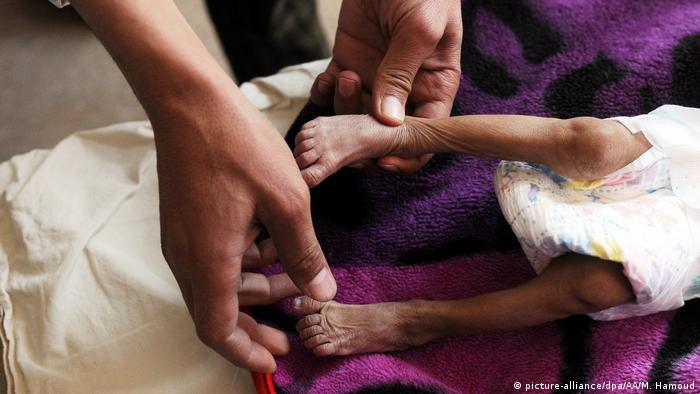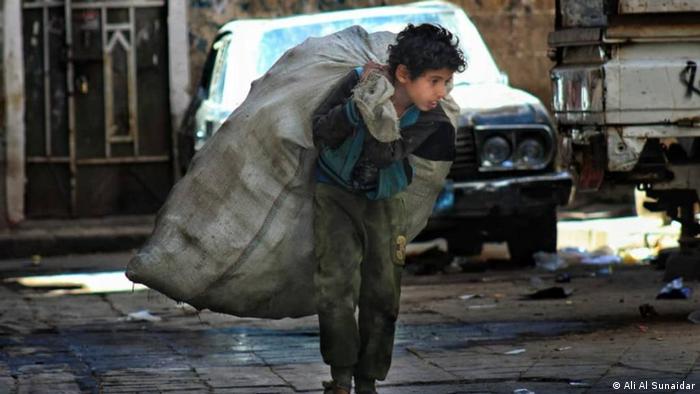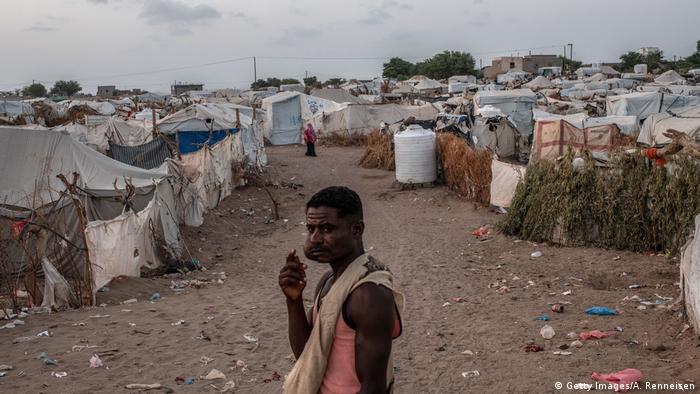In Yemen’s like a war, Hunger and poverty. Millions of people urgently need food and medical help. Especially young mothers and their children are affected. Gouri Sharma and Mohamed Hussein reports.

One meal per day – more was not able to give Fardous Hamran her two children in the past two months. The 39-Year-old is dependent on friends who give her food. Your nine-year-old son, Sam, and their seven-year-old daughter Mayar, therefore, usually only the traditional Yemenite Lahoh bread and yogurt. You lose weight rapidly. Sam today weighs three pounds less than even a few months ago. “I have a great fear that my children are the next that are to be seen on television as examples of malnutrition”, says Hamran in an interview with the German wave in their home city of Sanaa.
For the five-fold mother Safia Abduh, the days on which she has sent all their children to school, blurry memories. Her husband worked for the electricity Ministry. He was one of the 500,000 employees in the public service, whose salaries have not been paid for two years. Because the money for private lessons was missing, moved the children to a public school.
Work instead of school
Then Abduhs man was a victim of the current Cholera epidemic in Yemen. Two of the children are the main earners of the family are now. The 15-year-old Samir gets less than 1,500 Yemeni riyals (the equivalent of five Euro) per day for eight hours of work on a Khat plantation in a suburb of Sanaa. Millions of Yemenis chew the slightly intoxicating leaves of the Khat Plant.

Many children do not go to school anymore, because you need to earn money for their family
His 13-year-old brother, Fadhel all day to gather on the streets and in garbage cans, empty plastic bottles and sells them to recycling factories in the city. So you just come on the equivalent of about 130 Euro per month. For your 46-year-old mother, the decision to leave the school was to cope with, hard to come by. But you know that the two had no choice. “As you have told me that they go to school, I couldn’t talk them out of it,” she says. “I still have three other children that need something to eat.”
Millions of people do not have enough to eat
The fates of Safia Abduh and Fardous Hamran are no individual cases in Yemen. Rather, they are the Norm in a country that suffers according to the United Nations under the most severe humanitarian disaster in the world. About 22 million Yemenis – are 75 percent of the population – urgently need food, water and medical care. Almost two million children are severely malnourished.
In Yemen, Saudi Arabia, the United Arab Emirates and Sunni allies in four years against Iran are fighting the rebels-oriented Houthi. The armed conflict has one of the poorest countries in the world plunged into an even greater humanitarian crisis. The pressure on Western governments to prevent the collapse of the country.
The currency is losing value
The economy of the country is particularly affected by the war. According to the world Bank, around 40 per cent of Yemeni households have lost their main source of income in the last four years. The poverty rate rose to 80 percent. In September, the economic Situation has deteriorated once again, as the currency Rial has lost within two weeks, almost two-thirds of their value.

Many people have fled because of the fighting
Mustafa Nasr of the Yemeni non-governmental organization “Studies and Economic Media Center” (SEMC) reported that have worsened the economic situation since the beginning of the war steadily. He told Deutsche Welle: “The unprecedented devaluation of the Rial in September was the strongest blow.” For the first Time, there have been documented reports of people that had been spent in their time of Need leaves of plants to eat – and, although in the past three years, more than five billion dollars for humanitarian aid.
Prices for food rise
The loss in value of the Rial has led to a significant increase in the prices of goods. Data from SEMC six Yemeni governorates, including Aden, Taiz and Sana’a, show that basic foods such as flour, sugar, rice, edible oil and milk are 30 percent more expensive than in June. In comparison to September 2015, it costs as much as 92 percent more.
As a result, many retailers had to close their shops. “We can’t sell our Goods to these incredible Dollar-prices. All the grocery shops in our street, until the exchange rate is better,” says Abdul Razzaq al-Hababi, the owner of a warehouse in Sana’a. He knew that the people were suffering. “But we can’t risk in the face of this collapse of the sale of Goods.”
No end to the fighting in sight
In spite of the worsening humanitarian situation and the fighting continues, the number of civilian victims is rising. In August, during an air attack by the Saudi-led coalition were killed 40 children at a market in the Northern province of Saada. A total of approximately 10,000 civilians were so far killed. Independent organisations speak of more Victims. They criticize that the number had not been updated for years. There are claims of great Britain and the United States to stop arms exports to Saudi Arabia because there are more and more signs that weapons from the West to be used against the civilian population.
Yemen is a divided country – the Houthi rebels control much of the North including the capital Sanaa. The Rest, including the city of Aden, will be ruled out of the exile from the internationally-recognized President Abed Rabbo Mansur Hadi. An end to the conflict and to the suffering of the civilian population – is, despite the efforts of the United Nations not yet in sight.

